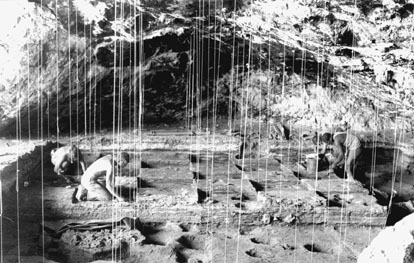

 | Page 63 |  |
in 1960, the number had grown to more than 100 by the end of the twentieth century. In South Africa, in addition to the Universities of Cape Town and Witwatersrand, archaeological courses are now offered at the Universities of Pretoria and Fort Hare—and until recently, Stellenbosch. Universities in Botswana, Zimbabwe, and Mozambique also offer archaeological training and are centers for research. The economic downturn in the 1990s has not been adequately compensated by an increase in opportunities in cultural resource and heritage management, and there is reduced employment for new graduates.

Large-scale excavation at Boomplaas Cave, 1970s. Workers are excavating the Khoekhoe stockpost levels; 2,000-year-old Later Stone Age storage pit horizon is exposed in the foreground.
(H. Deacon).
Part of coming of age was the adoption of new theoretical orientations. Archaeology generally was moving from a primary concern with documenting and ordering artifacts into periods to constructing histories of cultures. Heralded as “the new archaeology,” the paradigm of the 1960s was the processual movement, so-called because of the concern with the processes leading to the cultural changes in the past. This movement reflected a positivist approach in the natural and human sciences and had the benefit that archaeologists became more rigorously scientific in practice and more theoretically aware.
The positivist approach also provoked the criticism that explanations were too deterministic and did not take human agencies sufficiently into account. This criticism spawned a competing postprocessualist theoretical movement, which has taken a more relativist position, arguing that the past is created out of the present and there cannot be a single authoritative past. It has been a concern of archaeologists in South Africa that constructions of the past have been manipulated to disadvantage and undervalue the role of some groups and minorities lacking a written history. Although influenced by theoretical advances elsewhere and other disciplines, archaeology in South Africa has made significant contributions to the discipline’s development.
The long human occupation of the subcontinent and the high archaeological visibility of the prehistoric sites have made a number of fields a focus for research. These include the study of human origins, both the origins of humankind and the origins of modern humans; the study of the history of the San and recent hunter-gatherers;
 |  |